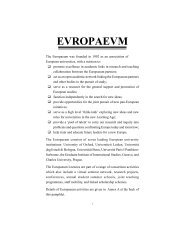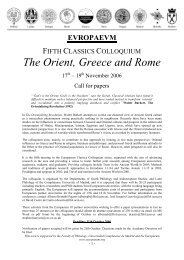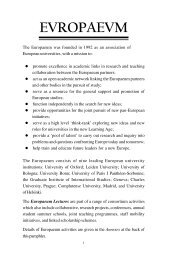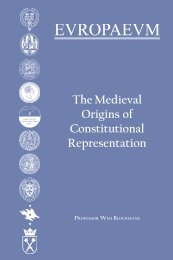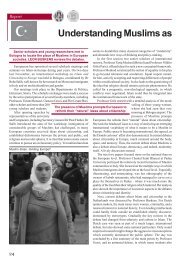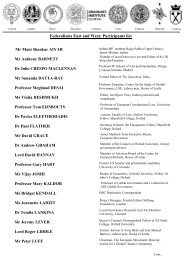Authors Iain Begg | Gabriel Glöckler | Anke Hassel ... - The Europaeum
Authors Iain Begg | Gabriel Glöckler | Anke Hassel ... - The Europaeum
Authors Iain Begg | Gabriel Glöckler | Anke Hassel ... - The Europaeum
Create successful ePaper yourself
Turn your PDF publications into a flip-book with our unique Google optimized e-Paper software.
Where do we come from? <strong>The</strong> EU agenda on<br />
employment growth and social inclusion<br />
It seems important to remember that the old member states of the EU<br />
originally consisted of a set of mature welfare states that during the 1970s<br />
and 1980s had achieved high levels of social equality – unmatched in<br />
other regions of the world. In the golden years of welfare expansion up<br />
until the 1980s, most member states had tended to respond to economic<br />
shocks and industrial restructuring by taking people out of the labour<br />
market and thereby reducing the employment rate. In contrast to other<br />
OECD countries, western Europe had relatively high shares of workers<br />
going into early retirement but also joining the ranks of the long-term<br />
unemployed. As has been well documented, Europe had developed a<br />
problem of employment creation while the liberal labour market of the<br />
US created many jobs but many with poor quality.<br />
<strong>The</strong> single European market programme of the 1980s – while liberalising<br />
many sectors of the European economy – initially even relied on the<br />
functioning of the mature welfare state during the process of restructuring,<br />
which was induced by the liberalisation of markets. Moreover, Jacques<br />
Delors framed the social agenda as a form of compensation for economic<br />
liberalisation and thereby implied that the EU would stand behind the<br />
role of the welfare state. While the EU did not have any responsibility in<br />
the area of welfare, the Commission well understood that welfare played a<br />
key role for the legitimacy of the Single European Market.<br />
In this light, first discussions on regulation and standards of minimum<br />
incomes started at the EU level in the early 1990s. In May, 1991, the<br />
Commission proposed a recommendation on minimum incomes in the<br />
follow-up of the Community Charter of Fundamental Social Rights of<br />
Workers (1989) and the affiliated action programme. This resulted in a<br />
“Minimum Income Recommendation” 3 enacted by the European Council<br />
which focused on the acknowledgment of the fundamental right to access<br />
resources and social assistance and on agreement of common principles<br />
for the enforcement of this right within the framework of national social<br />
security systems.<br />
<strong>The</strong> 1992 recommendation applies to all member states in the sense<br />
that governments generally should set minimum incomes, but – like all<br />
recommendations – it is not a legislative obligation. It has prompted a<br />
more comprehensive social security approach at least in some member<br />
states such as Portugal and Italy.<br />
132<br />
After the crisis: A new socio-economic settlement for the EU




